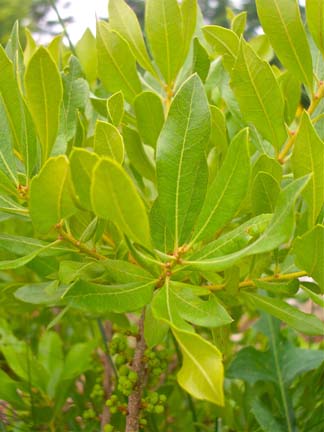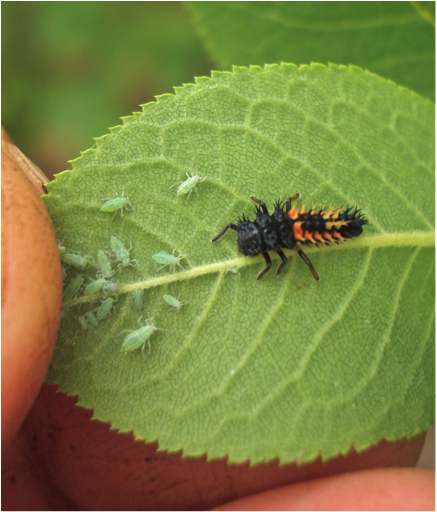Sound Gardening
Estuaries are the gardens of the oceans – filled with life and vital habitats for so many species, including us! In 1988, the United States Congress declared Long Island Sound as an estuary of national significance, recognizing both its ecological significance and the many threats to its survival. Do you think, as a landlubber, that you can’t help Long Island Sound? Not so! Your backyard is connected to the Sound, and you can help make a difference and protect this special place.
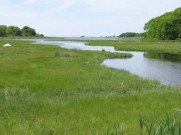
In the northeast we have an intricate network of small streams that combine, on their trek from higher elevations to sea level, into larger and larger streams until they hook up with our largest rivers. Streams are divided into watersheds based on elevation; all the streams that drain into the same river are said to be in the same watershed. In Connecticut, that means the Thames River in the southeast, the Connecticut River – which by itself contributes 70 percent of the freshwater that’s in Long Island Sound, and, in the southwest part of the state, the Housatonic River. On Long Island, the Nissequogue River has the largest discharge of any of the freshwater rivers into Long Island Sound.
That stream in your backyard, or the one that you pass on your way to school or work in the morning, is part of a living network of water that is constantly in motion.
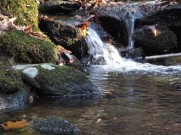
The nutrients that come off the land – leaves in the fall, the minerals in soil and the byproducts of plants and animals that live in the water, are carried to the ocean by these running waters and are an important contributor to the life in Long Island Sound. Similarly, aquatic species that migrate from the ocean up our rivers – such as shad, blueback herring and eels – bring ocean-based nutrients inland, such as the millions of eggs and fish fry (baby fish) that are spawned every spring that contribute food and nutrients to other organisms in the inland aquatic food web. To learn more about this, visit: StroudCenter.org
This exchange has been going on for as long as land and sea – and life – have occupied the planet. It’s not until unwanted elements appear in these waters that a problem develops. That’s where you and I come in.
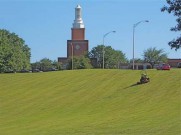
While natural systems are pretty resilient and can take care of excess amounts of unwanted elements – such as nitrogen, toxic chemicals, pathogens (such as bacteria), and even sediment, too much of anything can be a problem. Pollution in Long Island Sound is primarily the result of sewage – from sewage treatment plants and septic systems, and excess nutrients and other contaminants that run off our developed landscape. Too many nutrients – especially nitrogen – can create the conditions of low oxygen in bottom waters (hypoxia) that threaten undersea life.
That’s where Sound Gardening can help: how you manage your backyard, or encourage your town to manage theirs, can make a difference to the water quality – and living marine resources of Long Island Sound.
Where to Start
Organic Land Care
You may be able to make some simple changes to reduce your landscape’s potential impacts to Long Island Sound. The practice of organic land care provides ways to manage your home landscape to reduce the amount of nitrogen leaving your yard, and suggests non-toxic alternatives to pest control .
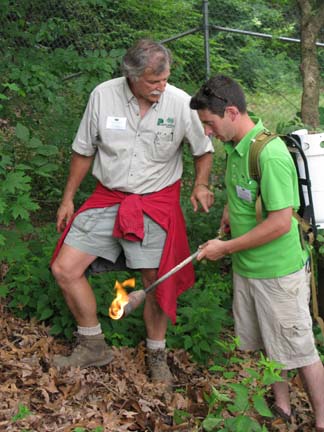

Soil
Happy soil is your best defense against disease, pests and drought conditions. A healthy soil community harbors the right balance of organic material, minerals and a complex and diverse insect and microscopic plant and animal community that continually works to overcome pest and disease problems. The best way to ensure good soil is to start with the right ingredients but even if you are dealing with poor existing soil conditions, adding compost and compost tea can provide a considerable boost to get your lawn and garden healthy and off a chemical diet. To best understand your existing soil conditions, be sure to get a soil test.
Compost and Compost Tea
Compost is organic matter that has been decomposed and recycled as a fertilizer and soil amendment . Compost is a key ingredient in organic land care, as it provides not only time released food, but helps regulate the temperature and moisture of the soil – both important for healthy plants (and soil animals). Compost tea is made from rich compost; by combining compost with water and plenty of air, healthy microorganisms infuse the water and provide a nutritious “broth” that, when fed to plants, helps them grow and resist disease.
Fertilizers
A healthy soil goes a long way toward providing the nutrients and other conditions necessary for successful plant growth. Time released, organic fertilizers (such as those made from bonemeal and bloodmeal), when added according to the recommendations of a soil analysis, will provide your landscape with the long term and continuous nutrition that builds strong plant tissue. Inorganic fertilizers are chemical solutions designed to provide a direct source of nutrients (generally nitrogen, potassium and potash) via water. Plants readily use these ingredients, but once their immediate nutrient needs are met, any excess cannot be absorbed and this becomes the source of excess nutrient runoff that can be harmful to water bodies, including Long Island Sound.
Lawns
Americans love their lawns, but lawns are often the source of environmental harm – through excess fertilizer and chemical use, and the replacement of productive insect and wildlife habitat with a near monotypic stand of one type of plant – grass. Lawns don’t have to go away; we just need to think about what our lawns are for, and how we can reduce them and eliminate harmful polluted byproducts from their traditional care. Organic lawn care is increasingly being made available from land care managers, and information about converting to organic lawn practices for the homeowner is in increasing demand. Even some relatively simple practices: mowing high, watering wisely, using compost and using the right grass for the right place, can go a long way toward sustaining a healthy lawn while protecting environmental resources .
Lawn alternatives
Increasingly, homeowners are seeking alternatives to traditional grass lawns that are expensive and time consuming to maintain, in addition to their potential environmental consequences. Wildflower meadows, alternative grass species that require less upkeep, alternative landscaping that includes planting shrubs, flowers and even ornamental grasses, and creating important wildlife habitat, are all techniques being used to reduce the size and dominance of the American lawn.
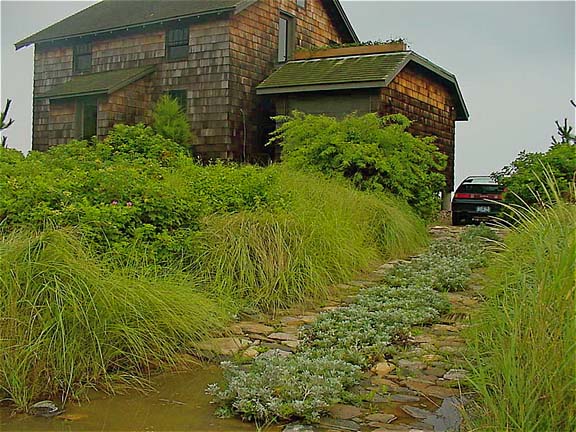
Alternative Landscaping / native plants
Although you may not be willing to part with your entire lawn, most landscape architects will encourage you to think about how you are using your existing lawn, and if you need all the lawn area that you currently maintain. If you want a place for kids and pets to play, why not make it a meaningful space that is free of chemicals and surrounded by diverse and interesting plants? Better yet, why not reduce the expense and time of maintaining a lawn by reducing its dominance in your landscape in favor of a more naturalized landscape?

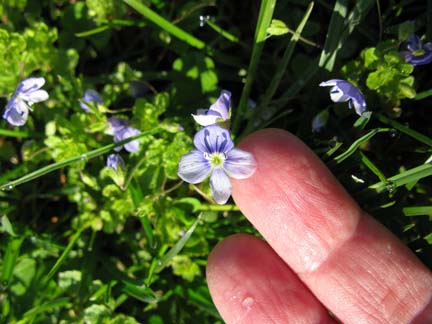
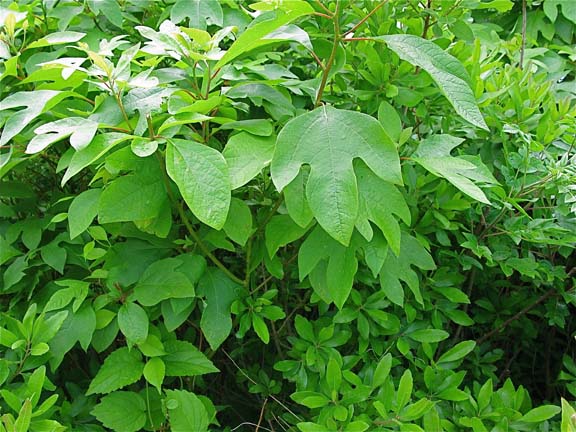
Gardens and Biodiversity
Entomologist and author Doug Tallamy has written compellingly about the connection between native plants and insects, and the important role of insects maintaining the diversity of our local landscapes. Many birds, for example, rely on the energy stored in insects to feed their young in the spring, and local solitary bees – important for pollination – rely on the timing and nutrition of native flowering trees, shrubs and flowers.
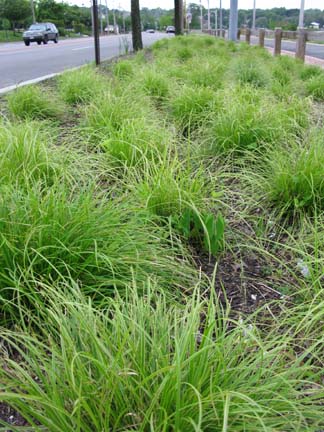
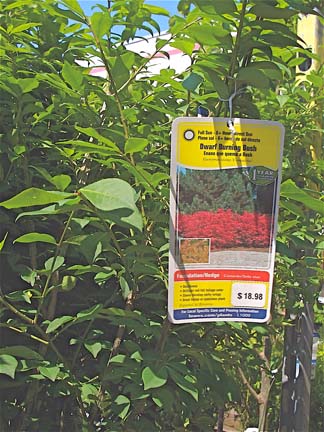
While you’re considering reducing your lawn, why not also make your yard a habitat friendly place for local wildlife? Habitats provide homes for natural predators such as ladybugs, birds, and frogs that in turn reduce the need for pesticides. For more information [national wildlife]. If planted in the correct place, native plants are used to our Connecticut growing conditions, making them more resistant to disease and less dependent on additional food and water.
Gardens and water quality/riparian buffers/rain gardens
Connecticut and Long Island have a multitude of small streams and waterways that eventually run into rivers and ultimately Long Island Sound. Because every waterway is connected in this way to the ocean, that stream in your backyard or down the road is an automatic conveyor belt for not only water, but also potential pollutants that can get into that water. If you live next to a stream, or know someone who does, consider creating a vegetated buffer to that stream. Depending on the type of soil, the slope to the water, and a few other factors, even a modest buffer can help slow water laden with fertilizer, pesticides or sediment, and allow plants and soil organisms to take up and detoxify polluted runoff before it reaches a waterway.
